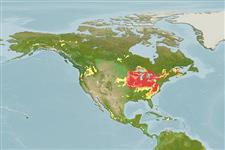Classification / Names
आम नाम | उपशब्द | Catalog of Fishes (gen., sp.) | ITIS | CoL | WoRMS | Cloffa
ऐकटीनोप्टीरेजी (रेज़-फिन्नढ मछलियाँ) >
Perciformes (Perch-likes) >
Centrarchidae (Sunfishes)
Etymology: Lepomis: Greek, lepis = scaled + Greek, poma = gill cover, operculum (Ref. 45335, 79012); gibbosus: gibbosus from gibbous, or like a full moon, referring to body shape (Ref. 1998).
पर्यावरण / जलवायु / सीमा
पारिस्थितिकी
; स्वच्छ जल, अलवण जल; खारा बेनथोपिलाजिक; pH range: 7.0 - 7.5; dH range: 10 - 15; पोटामोड़िरोमस (Ref. 51243). Temperate; 4°C - 22°C (Ref. 1672), preferred ?; 50°N - 30°N
North America: New Brunswick in Canada to South Carolina in the USA; Great Lakes, Hudson Bay and upper Mississippi basins from Quebec and New York west to southeast Manitoba and North Dakota, and south to north Kentucky and Missouri. Widely introduced. Several countries report adverse ecological impact after introduction.
आकार / वज़न / Age
Maturity: Lm ? range ? - ? cm
Max length : 40.0 cm TL पुल्लिंग / अलिंग; (Ref. 5723); common length : 9.9 cm TL पुल्लिंग / अलिंग; (Ref. 12193); अधिकतम प्रकाशित वज़न: 630.00 g (Ref. 4699); अधिकतम सूचित उम्र: 12 वर्षो (Ref. 72493)
पृष्ठीय रीढ़ (सम्पूर्ण): 10 - 12; पृष्ठीय सौफट रेज़ (सम्पूर्ण): 10-12; गुदा कांटा 3; ऐनल सौफट रेज़: 8 - 11; जानवरों की रीड़ का जोड़: 28 - 30
Adults inhabit vegetated lakes and ponds, as well as vegetated pools of creeks and small rivers (Ref. 5723). They feed on small fishes and other vertebrates (Ref. 1998), as well as fish eggs (Ref. 2058). An introduced species in Europe which avoids swift waters and occurs in estuaries with a salinity up to 18.2 ppt (Ref. 59043). Reported in Europe to prey on a wide variety of invertebrates (Ref. 59043). Considered undesirable catch (Ref. 30578).
Males build the nest on very shallow waters near the shore. The pair then swims in a circular path over the nest and eggs and sperm is released in intervals. The male guards the eggs for about 7 days (Ref. 93240) and the young (to about 11 days after hatching), then prepares the nest for another spawning with the same or different females (Ref. 1998). In European waters, each male may spawn with several females in one nest and guard the nest until abandoned by larvae (Ref. 59043). Produces up to 1000 eggs (Ref. 1672).
Page, L.M. and B.M. Burr, 1991. A field guide to freshwater fishes of North America north of Mexico. Houghton Mifflin Company, Boston. 432 p. (Ref. 5723)
IUCN Red List Status (Ref. 115185)
CITES (Ref. 94142)
Not Evaluated
Threat to humans
Potential pest
Human uses
मात्स्यिकी: निर्वाह मात्स्यिकी; आखेट मत्स्य: हां; जलजीवालय: व्यापारिक
अधिक जानकारी
संदर्भजलीयकृषिजलीयकृषि रूपरेखाखींचआनुवंशिकीऐल्लि आवृतियाँहैरेटिबिलटीबीमारीप्रक्रमणMass conversion
साधन
Special reports
Download XML
इंटरनेट स्रोत
